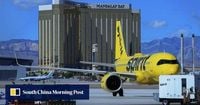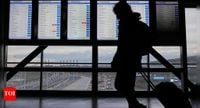Travelers across the United States are bracing for what could become one of the most disruptive periods in American aviation history, as the government shutdown—now at 35 days and counting—threatens to force the closure of portions of the nation’s airspace. Transportation Secretary Sean Duffy, in a series of urgent warnings this week, painted a stark picture of what lies ahead if Congress fails to break its deadlock and reopen the government in the coming days.
“So if you bring us to a week from today, Democrats, you will see mass chaos,” Duffy declared at a press conference Tuesday, according to AFP. “You will see mass flight delays. You’ll see mass cancellations, and you may see us close certain parts of the airspace, because we just cannot manage it because we don’t have the air traffic controllers.”
The Department of Transportation’s warnings are not idle threats. Nearly half of all major air traffic control facilities are already facing critical staffing shortages, the Federal Aviation Administration (FAA) reports. About 13,000 air traffic controllers are currently working without pay, and the strain is starting to show. On November 1, the FAA revealed that 80 percent of New York area controllers had called out, leaving one of the nation’s busiest airspaces dangerously understaffed.
The numbers are staggering: more than 60,000 air traffic controllers and Transportation Security Administration (TSA) staff are working without pay, and the White House has cautioned that rising absenteeism could soon lead to even longer security lines and delays at airports nationwide. Bryan Bedford, FAA Administrator, told Fox Business’ Varney and Co that at the agency’s 30 largest airports, “anywhere from 20 to 40 percent of our controllers aren’t coming to work.”
For travelers, the impact is already being felt. Airlines estimate that over the past month, some 3.2 million passengers have been caught up in delays or outright cancellations due to the spike in air traffic controller absences. On November 5, the FAA was forced to delay a new round of flights as the shutdown’s effects rippled through the system. The scene at airports like George Bush Intercontinental in Houston has become all too familiar: long lines, mounting frustration, and a sense of uncertainty about what the next day will bring.
Duffy’s warnings have grown more dire as the shutdown drags on. At an event in Philadelphia on Monday, he sympathized with the plight of air traffic controllers, who are now entering their second month without wages. “These hard-working Americans have bills to pay, and they are being forced to make decisions and choices,” Duffy said, as quoted by ABC News. “Do they go to work as an air traffic controller, or do they have to find a different job to get resources, money, to put food on their table, to put gas in their car? And as every day goes by, I think the problem is only going to get worse, not better.”
Many controllers, Duffy noted, have already taken on second jobs—waiting tables, driving for ride-share companies, or whatever it takes to make ends meet. Some are covering two positions at once because their colleagues have called in sick or are simply unable to continue working without pay. “They have to work those two positions because their colleagues have called in sick or they’re waiting tables or they’re driving Uber,” Duffy explained, according to the Daily Star.
Just a month ago, Duffy took a harder line, telling Fox Business’ Varney & Co, “If we have some on our staff that aren’t dedicated, we’re going to let them go.” But as the shutdown’s impact has deepened, he has softened that stance, telling CBS’ Face the Nation that, “They need support, they need money, they need a paycheck. They don’t need to be fired.”
Still, the safety of the flying public remains Duffy’s top concern. “There is a level of risk that gets injected into the system when we have a controller that’s doing two jobs instead of one,” he said on ABC News’ This Week. “But with this shutdown, it would be dishonest to say that more risk is not injected into the system.” He emphasized that the FAA and Department of Transportation will close or restrict airspace whenever it is deemed unsafe. “People always ask me is the system safe, and I would tell you yes, the system is safe—and if it wasn’t, we would shut it down. But with this shutdown, it would be dishonest to say that more risk is not injected into the system.”
The roots of the crisis run deep in the political standoff gripping Washington. The shutdown, which began on October 1—the first in seven years—was triggered when Republican and Democrat lawmakers failed to agree on a spending bill. At the heart of the impasse is a bitter dispute over healthcare funding. Democrats have demanded an extension of subsidies that help millions of Americans afford health insurance, while President Trump has refused to negotiate until the shutdown ends.
The gridlock shows few signs of abating. On November 5, a House-approved resolution to reopen the government failed again in the Senate—the 14th such rejection. Democrats, for their part, have remained firm. House Democratic Leader Hakeem Jeffries said, “We will not support a partisan Republican spending bill that continues to gut the healthcare of the American people. That’s been our position week after week after week, and it will continue to be our position because the Republican healthcare crisis is crushing the American people.” He added, “Now that we’re in the midst of open enrollment, tens of millions of Americans all across the country are realizing that their premiums, co-pays and deductibles are going to skyrocket, in some cases $1,000 to $2,000 more per month that working-class Americans are being asked to pay.”
Republicans, meanwhile, have sought to shift blame, arguing that Democrats are holding the government—and by extension, the nation’s air travel system—hostage over healthcare funding. Duffy himself was explicit in attributing the looming crisis to Democratic inaction, stating, “So if, if you bring us to a week from today, Democrats, you will see mass chaos.”
For now, the question on the minds of millions of travelers, airline workers, and public officials is simple: How much longer can the system hold? The shutdown’s effects are multiplying, and the possibility of airspace closures is no longer a distant threat, but a looming reality. As Duffy put it, “We’ve tried to pull every dollar we can for different programs where we’re legally allowed to pull and fund. But the truth is, the law doesn’t allow me to say, ‘the Congress hasn’t funded the government, I can just go find money and pay air traffic controllers.’ That’s not the way our Constitution works and our government works.”
With Congress deadlocked and the shutdown poised to become the longest in U.S. history, the nation’s air travelers face an uncertain—and increasingly turbulent—future.


